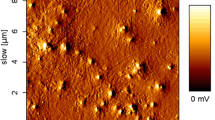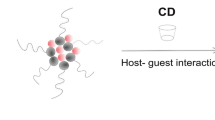Abstract
Purpose
To investigate the self-assembly of polyethylene glycol (PEG)-phosphatidylethanolamine (PE) conjugate with water-soluble drugs (doxorubicin hydrochloride, vinorelbine tartrate and vincristine sulfate) and give insight into the mechanism of formation and mode of interaction of the drug with PEG-PE as well as the general principles of self-assembly using pegylated lipid micelles.
Methods
One-step self-assembly method to prepare drug-loaded micelles was developed. The micelles were characterized by dynamic light scattering, transmission electron microscopy, encapsulation efficiency, and release study. NMR was used to study molecular assembly of PEG-PE with doxorubicin.
Results
Doxorubicin hydrochloride and vinorelbine tartrate were entrapped into micelles with high efficiency of >99.0% at molar ratios of 1:1 and 2:1 of PEG-PE to drugs, respectively. Drug loading did not measurably perturb either the geometry or the size. It was found that electrostatic interaction and hydrophobic forces are responsible for the intercalation of drugs into PEG-PE micelles. NMR data revealed that the anthracycline ring of doxorubicin was inserted between PE phospholipids, and its amino sugar located in the outer shell of micelle between PEG chains.
Conclusion
Based on our results, the structure and self-assembly mechanism of water-soluble drugs encapsulated in PEG-PE micelles were proposed.








Similar content being viewed by others
References
Maeda H, Wu J, Sawa T, Matsumura Y, Hori K. Tumor vascular permeability and the EPR effect in macromolecular therapeutics: a review. J Control Release. 2000;65:271–84.
Kwon GS. Polymeric micelles for delivery of poorly water-soluble compounds. Crit Rev Ther Drug Carrier Syst. 2003;20:357–403.
Torchilin VP. Targeted polymeric micelles for delivery of poorly soluble drugs. Cell Mol Life Sci. 2004;61:2549–59.
Matsumura Y, Hamaguchi T, Ura T, Muro K, Yamada Y, Shimada Y, et al. Phase I clinical trial and pharmacokinetic evaluation of NK911, a micelle-encapsulated doxorubicin. Br J Cancer. 2004;91:1775–81.
Kuroda J, Kuratsu J, Yasunaga M, Koga Y, Saito Y, Matsumura Y. Potent antitumor effect of SN-38-incorporating polymeric micelle, NK012, against malignant glioma. Int J Cancer. 2009;124:2505–11.
Matsumura Y. Poly (amino acid) micelle nanocarriers in preclinical and clinical studies. Adv Drug Deliv Rev. 2008;60:899–914.
Danson S, Ferry D, Alakhov V, Margison J, Kerr D, Jowle D, et al. Phase I dose escalation and pharmacokinetic study of pluronic polymer-bound doxorubicin (SP1049C) in patients with advanced cancer. Br J Cancer. 2004;90:2085–91.
Lee KS, Chung HC, Im SA, Park YH, Kim CS, Kim SB, et al. Multicenter phase II trial of Genexol-PM, a Cremophor-free, polymeric micelle formulation of paclitaxel, in patients with metastatic breast cancer. Breast Cancer Res Treat. 2008;108:241–50.
Torchilin VP. Recent advances with liposomes as pharmaceutical carriers. Nat Rev Drug Discov. 2005;4:145–60.
Lukyanov AN, Gao Z, Mazzola L, Torchilin VP. Polyethylene glycol-diacyllipid micelles demonstrate increased acculumation in subcutaneous tumors in mice. Pharm Res. 2002;19:1424–9.
Gao Z, Lukyanov AN, Singhal A, Torchilin VP. Diacyllipid-polymer micelles as nanocarriers for poorly soluble anticancer drugs. Nano Lett. 2002;2:979–82.
Musacchio T, Laquintana V, Latrofa A, Trapani G, Torchilin VP. PEG-PE micelles loaded with paclitaxel and surface-modified by a PBR-ligand: synergistic anticancer effect. Mol Pharm. 2009;6:468–79.
Sawantand RR, Torchilin VP. Enhanced cytotoxicity of TATp-bearing paclitaxel-loaded micelles in vitro and in vivo. Int J Pharm. 2009;374:114–8.
Noble RL. The discovery of the vinca alkaloids–chemotherapeutic agents against cancer. Biochem Cell Biol. 1990;68:1344–51.
Tritonand TR, Yee G. The anticancer agent adriamycin can be actively cytotoxic without entering cells. Science. 1982;217:248–50.
Van Vleetand JF, Ferrans VJ. Myocardial diseases of animals. Am J Pathol. 1986;124:98–178.
Lobert S. Neurotoxicity in cancer chemotherapy: vinca alkaloids. Crit Care Nurse. 1997;17:71–9.
Shenasa H, Calderone A, Vermeulen M, Paradis P, Stephens H, Cardinal R, et al. Chronic doxorubicin induced cardiomyopathy in rabbits: mechanical, intracellular action potential, and beta adrenergic characteristics of the failing myocardium. Cardiovasc Res. 1990;24:591–604.
Tang N, Du G, Wang N, Liu C, Hang H, Liang W. Improving penetration in tumors with nanoassemblies of phospholipids and doxorubicin. J Natl Cancer Inst. 2007;99:1004–15.
Vakiland R, Kwon GS. Effect of cholesterol on the release of amphotericin B from PEG-phospholipid micelles. Mol Pharm. 2008;5:98–104.
Vernooij EA, Gentry CA, Herron JN, Crommelin DJ, Kettenes-van den Bosch JJ. 1H NMR quantification of poly(ethylene glycol)-phosphatidylethanolamine in phospholipid mixtures. Pharm Res. 1999;16:1658–61.
Lukyanovand AN, Torchilin VP. Micelles from lipid derivatives of water-soluble polymers as delivery systems for poorly soluble drugs. Adv Drug Deliv Rev. 2004;56:1273–89.
Fournier E, Dufresne MH, Smith DC, Ranger M, Leroux JC. A novel one-step drug-loading procedure for water-soluble amphiphilic nanocarriers. Pharm Res. 2004;21:962–8.
Patel SK, Lavasanifar A, Choi P. Roles of nonpolar and polar intermolecular interactions in the improvement of the drug loading capacity of PEO-b-PCL with increasing PCL content for two hydrophobic Cucurbitacin drugs. Biomacromolecules. 2009;10:2584–91.
Acknowledgements
This work was supported by grants from the National Nature Sciences Foundation of China (No. 90606019, 30901869), China Postdoctoral Science Foundation (No. 20090450598), State Key Development Plan Project (2006CB933305, 2007CB935801) and China-Finland Inter-Governmental S&T Cooperation Project (2008DFA01510).
Author information
Authors and Affiliations
Corresponding authors
Rights and permissions
About this article
Cite this article
Wang, Y., Wang, R., Lu, X. et al. Pegylated Phospholipids-Based Self-Assembly with Water-Soluble Drugs. Pharm Res 27, 361–370 (2010). https://doi.org/10.1007/s11095-009-0029-6
Received:
Accepted:
Published:
Issue Date:
DOI: https://doi.org/10.1007/s11095-009-0029-6




